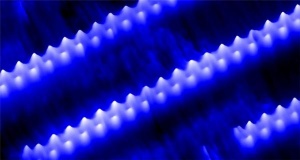Apr 7 2009
Scientists at the University of Liverpool have discovered a five-sided ice chain structure that could be used to modify future weather patterns.
 A newly discovered five-sided ice chain structure could be used to modify future weather patterns. (Credit: Photo courtesy of Matt Forster, University of Liverpool)
A newly discovered five-sided ice chain structure could be used to modify future weather patterns. (Credit: Photo courtesy of Matt Forster, University of Liverpool)
Researchers, in collaboration with University College London and the Fritz-Haber Institut in Berlin, created the first moments of water condensing on matter – a process vital for the formation of clouds in the atmosphere – by analysing how the two interact on a flat copper surface. Ice has rarely been viewed at the nanoscale before and the team discovered a one-dimensional chain structure built from pentagon-shaped rings, rather than the more commonly seen hexagonal structures of ice formations like those seen in snowflakes.
This discovery could lead to scientists developing new materials for seeding clouds and causing rain. Cloud seeding is a form of weather modification, where the amount or type of precipitation that falls from clouds is altered by dispersing substances into the air which modify cloud particles. This process can increase amounts of rain and snow but can also be used to suppress hail and fog. The substances currently used to seed clouds are chosen to bind to hexagonal ice, but this work suggests that the process could work equally well with materials which bind to other structures.
Professor Andrew Hodgson, from the University’s Surface Science Research Centre, said: “Water is a ubiquitous material that is central to many biological and chemical reactions, but its influence is often indirect and difficult to understand. Water usually takes on hexagonal arrangements, like those seen in snowflakes, yet this research has shown that the intricate, nanoscale structure of ice can actually be built from one-dimensional pentagons.
“Ice crystals form against flat, solid surfaces and watching the microscopic process take place on copper has provided detailed information on how ice forms at interfaces. The research will help to improve our understanding of how ice patterns form and how water is structured at metal interfaces.
“Many important chemical reactions take place at interfaces so understanding the structure of water in these environments will allow scientists to make better models of these processes. With a better understanding of how ice crystals form in the upper atmosphere, new and cheaper materials could now be developed that could be used across the globe to seed clouds and modify weather patterns."